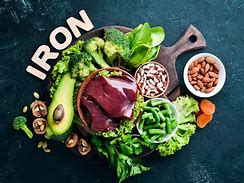Articles

Iron
Everything You Need
to Know About Iron
Functions of Iron
- Iron is essential in the formation of hemoglobin,
the protein that gives red blood cells their red color.
- Hemoglobin in red blood cells transports
oxygen to all the body’s cells, helping to produce energy and maintain
cellular function.
Sources of Iron
- Liver
- Kidneys
- Chicken meat
- Leafy green vegetables
- Fish
- Legumes
Iron Absorption
- In animal-based foods, iron is
found in the ferrous form, which is more easily absorbed.
- In plant-based sources, iron is
found in the ferric form, which is less readily absorbed. It
must first be converted into the active ferrous form inside the
body.
- Plant sources like grains, leafy greens,
and soy protein contain phytic acid, a compound that inhibits
iron absorption.
- Vitamin C enhances iron absorption from plant-based
foods by converting iron from ferric to ferrous form.
For example, adding lemon to spinach can improve iron absorption.
Iron Requirements
- Red blood cells regenerate every 120
days, and the body must continually replace iron to support this
cycle.
- During pregnancy, iron needs
increase to support fetal development, especially in the last trimester.
Iron supplements are often recommended under the supervision of a
physician or dietitian.
Specific Needs
- Newborns: Babies are born with enough iron stores for about 6 months. After
that, iron-rich foods are needed as solid foods are introduced,
since breast milk contains only a small amount of iron.
- Girls and women: Menstrual blood loss leads to iron
loss that must be replenished.
- Surgical patients: Blood loss during surgery may require iron
replenishment.
Iron Deficiency
Symptoms
Iron deficiency can
lead to anemia, with common symptoms such as:
- Fatigue and tiredness
- Pale skin
- Loss of appetite
- Cold hands and feet
